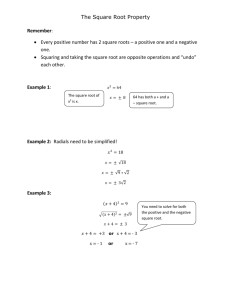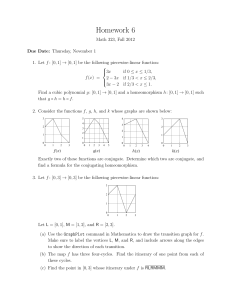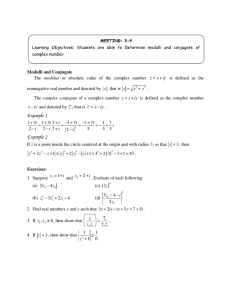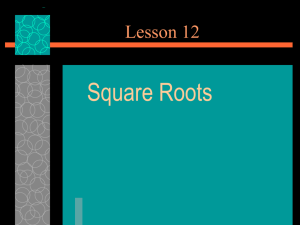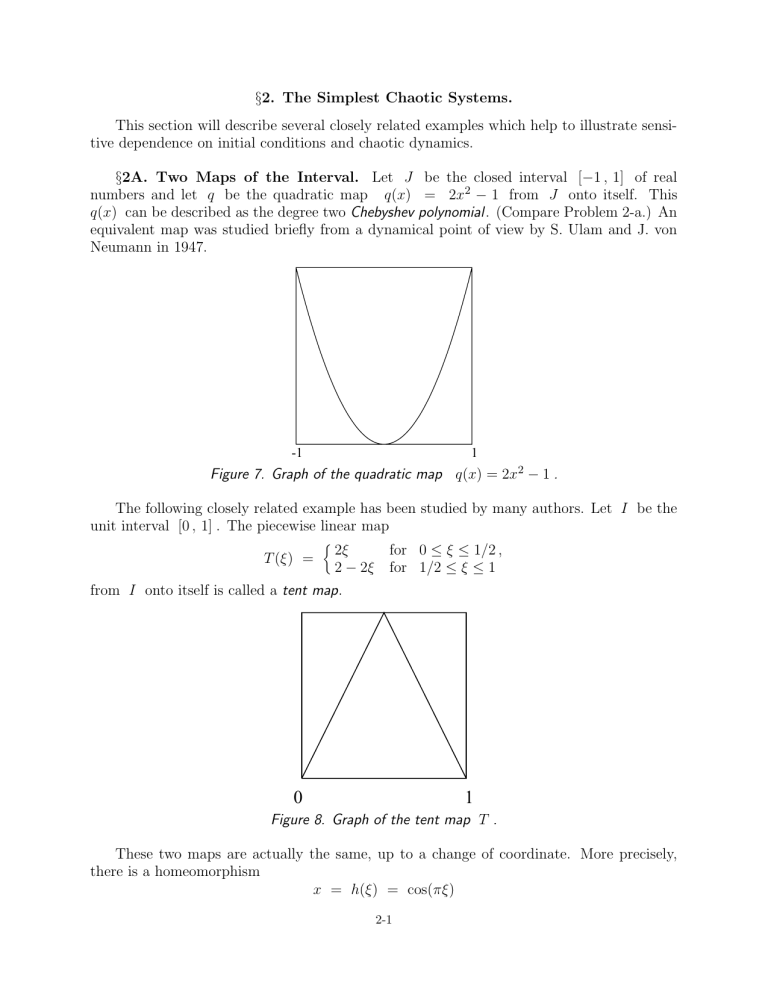
§2. The Simplest Chaotic Systems.
This section will describe several closely related examples which help to illustrate sensitive dependence on initial conditions and chaotic dynamics.
§2A. Two Maps of the Interval. Let J be the closed interval [−1 , 1] of real
numbers and let q be the quadratic map q(x) = 2x2 − 1 from J onto itself. This
q(x) can be described as the degree two Chebyshev polynomial. (Compare Problem 2-a.) An
equivalent map was studied briefly from a dynamical point of view by S. Ulam and J. von
Neumann in 1947.
-1
1
Figure 7. Graph of the quadratic map q(x) = 2x2 − 1 .
The following closely related example has been studied by many authors. Let I be the
unit interval [0 , 1] . The piecewise linear map
T (ξ) =
½
2ξ
2 − 2ξ
from I onto itself is called a tent map.
for 0 ≤ ξ ≤ 1/2 ,
for 1/2 ≤ ξ ≤ 1
0
1
Figure 8. Graph of the tent map T .
These two maps are actually the same, up to a change of coordinate. More precisely,
there is a homeomorphism
x = h(ξ) = cos(πξ)
2-1
2. SIMPLEST CHAOTIC SYSTEMS
h(ξ)
h(T(ξ)) = q(h(ξ))
ξ
T(ξ)
Figure 9. Topological conjugacy h from T onto q .
from the interval I onto the interval J so that h(T (ξ)) = q(h(ξ)) for every ξ ∈ I . In
other words, the following diagram is commutative,
T
I
−→
↓h
q
J
−→
I
↓h
J
(2 : 1)
so that we can write q = h ◦ T ◦ h−1 . We say that T is topologically conjugate to q , or
that h conjugates T to q . (Compare §4.) The proof that this diagram (2 : 1) commutes
is an easy exercise based on the identity
cos(2θ) = cos(2π − 2θ) = cos2 (θ) − sin2 (θ) = 2 cos2 (θ) − 1 .
Remarks: The two maps q and T seem rather different. For example one is smooth
while the other is not smooth at the origin. It is remarkable that the conjugating homeomorphism h is smooth, with smooth inverse except at the two endpoints. Note that h reverses
orientation. Hence it takes an interior maximum point for T to an interior minimum point
for q . (Similarly, q is conjugate under a linear change of coordinates to the logistic map
x 7→ 4 x (1 − x) , with an interior maximum point. Compare (1: 4) in §1.)
——————————————————
§2B. Angle Doubling: the Squaring Map on the Circle. Let S 1 ⊂ C be the
unit circle, consisting of all complex numbers z = x + iy with |z|2 = x2 + y 2 equal to one.
The squaring map P2 (z) = z 2 carries each point z = eiθ on the circle to the point e2iθ .
In other words, it doubles the angle θ , which is well defined modulo 2π . In practice, it
is often more convenient to set θ = 2πτ , where τ is a real number which is well defined
modulo one. We will write
z = e2πiτ
with
2-2
τ∈ / .
2B. ANGLE DOUBLING
Thus the squaring map P2 : S 1 → S 1 is topologically conjugate to the doubling map
m2 (τ ) ≡ 2 τ
(mod )
on the circle of real numbers modulo one.
z2
z=x+iy
θ = 2πτ
Re
q(x)
x
Figure 10. Angle doubling and the quadratic map q .
This is closely related to the quadratic map q . In fact the projection map
Re : S 1 → [−1 , 1]
which carries each z = x + iy ∈ S 1 to its real part Re(z) = x satisfies
Re((x + iy)2 ) = x2 − y 2 = 2x2 − 1 = q(x) .
We will say briefly that the projection map Re(x + iy) = x semi-conjugates the squaring
map P2 to the quadratic map q .
Newton’s Method: a Chaotic Case. Here is a curious variant of the angle doubling
example. Recall that Newton’s method for solving a polynomial equation f (x) = 0 involves
iterating an associated rational map
N (x) = x − f (x)/f 0 (x)
where f 0 is the first derivative of f . Note that the fixed points N (x) = x are precisely
the roots f (x) = 0 . If we start with any point x0 which is sufficiently close to a root x̂ of
f , then the orbit N : x0 7→ x1 7→ x2 7→ . . . , where xk+1 = N (xk ) , will always converge
to x̂ . Suppose however that we choose f (x) = x2 + 1 , with no real roots. Then
x2 + 1
= (x − x−1 )/2 .
(2 : 2)
2x
If we start with any real x0 , then the sequence N : x0 7→ x1 7→ · · · of real numbers cannot
converge, since N has no real fixed point. Thus Newton’s algorithm cannot converge;
instead it seems to have a nervous breakdown, and jumps about chaotically.
To understand this example properly, since N (0) = ∞ , it is necessary to compactify
the real numbers by adding a point at infinity, thus forming the real projective line. It is not
difficult to check that the resulting map N from ∪ ∞ to itself is topologically conjugate
to the squaring map P2 : S 1 → S 1 . (See Problem 2-e below.)
N (x) = x −
2-3
2. SIMPLEST CHAOTIC SYSTEMS
Figure 11. The map N (x) = (x − x−1 )/2 .
Remark. Still another topologically conjugate map is illustrated in Figure 6 (left).
——————————————————
§2C. Sensitive Dependence. This angle doubling example displays sensitive dependence 1 on initial conditions in a very transparent form. Consider an orbit
m2 : τ0 7→ τ1 7→ τ2 7→ · · · .
In other words, suppose that the elements τ0 , τ1 , τ2 , . . . of / satisfy the precise congruence τk+1 ≡ 2τk (mod ) for every k ≥ 0 . Suppose however that we can measure the
initial value τ0 only to within an accuracy of ² . Then we can predict the value of:
τ1
τ2
τ3
to an accuracy of
to an accuracy of
to an accuracy of
···
2²
4²
8²
and so on; we can predict the value of τ10 to an accuracy of 1024 ² , and τ20 to an
accuracy of 1048576 ² . If we choose n large enough so that 2n ² > 1 , then our approximate
measurement of τ0 will provide no information at all about τn .
Similar remarks apply to the quadratic map q , the tent map T , and to the Newton
map N . For example, suppose that
q : x0 7→ x1 7→ x2 7→ · · ·
is a precise orbit for the quadratic map q . An approximate measurement for x0 will
show, for example, that it lies in some interval [α, β] , and hence that a corresponding angle
τ = arccos(x)/2π lies in an interval between arccos(β)/2π and arccos(α)/2π . If ² is the
length of this last interval, and if 2n ² > 1 , then similarly we have no information at all
about the correct value for xn .
——————————————————
§2D. Symbolic Dynamics: The One-Sided 2-Shift. We can represent each of these
examples by a symbolic coding. The case of the doubling map m2 : / → / is easiest
1 For a precise definition, see §4D.
2-4
2E. THE SOLENOID
to see. Represent each τ0 ∈ [0, 1] by its base two expansion
τ0 = 0 . b0 b1 b2 · · · (base 2) = b0 /2 + b1 /4 + b2 /8 + · · · ,
(2 : 3)
where each bit bn is either zero or one. Then
2 τ0 = b0 . b1 b2 b3 · · · (base 2) ,
and reducing modulo one we get
τ1 = 0 . b1 b2 b3 · · · (base 2) ,
with τ1 ≡ 2 τ0 (mod ) . Thus the doubling map modulo one corresponds to the shift map
σ(b0 , b1 , b2 , . . .) = (b1 , b2 , b3 , . . .)
on the space of all one-sided infinite sequences of zeros and ones. We can give this space
of sequences the structure of a totally disconnected compact metric space, for example by
defining the distance function:
d((b0 , b1 , . . .) ,
(b00 ,
b01 ,
. . .)) =
∞
X
0
We will use the notation {0, 1}
for the set of natural numbers.
|b0n − bn |/2n .
for the resulting space, where
= {0, 1, 2, · · ·} stands
Topologically, the space {0, 1} is a Cantor set. It is not difficult to check that the shift
map σ on {0, 1} exhibits sensitive dependence on initial conditions. (For a dynamical
system embedded in Euclidean space which is topologically conjugate to this shift map, see
Figure 6 right.) Evidently the formula (6) describes a mapping from {0, 1} onto /
which semi-conjugates the shift map σ : {0, 1} → {0, 1} to the doubling map m2 .
Compare Problem 2-c.
——————————————————
§2E. The Solenoid. (Compare [Shub].) First consider a rather trivial modification of
the squaring map of §2B. Consider the product manifold S 1 × C embedded in C × C , and
the map
F0 (z, w) = (z 2 , λw)
from S 1 × C to itself, where λ is some constant with 0 < |λ| < 1 . Then clearly the
w -coordinate tends to zero as we iterate F0 . Thus all orbits converge towards the circle
S 1 × {0} , and F0 maps this circle onto itself by the squaring map. This provides a simple
example of a smooth “attractor” with chaotic dynamics.
Now suppose we perturb this mapping to
F² (z, w) = (z 2 , ² z + λw) ,
where ² is some non-zero constant which may be very small. Then we will see that the
geometry changes drastically. The precise choice of ² doesn’t matter here, since every such
F² is smoothly conjugate to the map
F1 (z, w) = (z 2 , z + λw)
under the conjugating transformation (z, w) 7→ (z , w/²) . Thus it suffices to study F 1 .
2-5
2. SIMPLEST CHAOTIC SYSTEMS
Figure 12. Left: Picture of the solid torus T (embedded in 3-space),
and of the
T ◦n
sub-torus F1 (T ) which winds twice around it. Right: The solenoid f (T ) .
Let T ⊂ S 1 × C be the solid torus consisting of all (z, w) with |w| ≤ c , where the
constant c ≥ 2 is to be chosen as follows. If |λ| < 1/2 , take c = 2 ; but otherwise choose
any c which is large enough so that 1 + c|λ| < c . First note the following:
Assertion. Every orbit of F1 in S 1 ×C eventually lands in this solid torus T ,
and the image F1 (T ) is strictly contained in the interior of T . Furthermore, if
|λ| < 1/2 , then T maps diffeomorphically onto its image, which is therefore a
solid torus smoothly embedded in the interior of T .
Proof. Let k = 1/c + |λ| < 1 . Note that the second coordinate of F1 (z, w) =
z + λw) satisfies
|z + λw| ≤ 1 + |λw| .
(z 2 ,
If |w| ≤ c , then the right hand side is ≤ 1 + c|λ| < c . On the other hand, if |w| > c , then
this right hand side is < |w|/c + |λw| = k |w| . Since the factor k = 1/c + |λ| is strictly less
than 1 , the successive values of |w| must decrease geometrically until |w| ≤ c .
Finally, in the case |λ| < 1/2 , if F1 (z, w) = F1 (z 0 , w0 ) with (z, w) 6= (z 0 , w0 ) , then it
is easy to check that z 0 must be equal to −z . The equation z + λw = −z + λw 0 with
|w| , |w 0 | ≤ c = 2 then leads to a contradiction, since 2 z = λ(w 0 −w) with |λ(w 0 −w)| < 2 .
Thus F1 restricted to T is one-to-one. This map is clearly smooth with smooth inverse. ¤
It follows that the successive images
T ⊃ f (T ) ⊃ f ◦2 (T ) ⊃ · · ·
form a nested sequence of compact sets. Let
A =
\
f ◦n (T )
be their intersection. It follows that every orbit of F1 converges towards this compact set
A . There is an obvious semi-conjugacy
(z, w) 7→ z
which carries this compact set A onto the circle. Thus the dynamics of F1 restricted to
2-6
2E. THE SOLENOID
this “attractor” A is at least as complicated as the dynamics of the squaring map on S 1 .
If |λ| < 1/2 , then we can describe the geometry more precisely. The image F1 (T ) is
a solid torus which wraps twice around T , and shown in Figure 12. Similarly, the second
image f ◦2 (T ) wraps four times around T , and so on. Although the original mapping F1
from S 1 × C is two-to-one, and the squaring map on S 1 is also two-to-one, it is interesting
T
to note that F1 maps the attractor A = f ◦n (T ) homeomorphically onto itself (still
assuming that |λ| < 1/2 ). In order to understand this passage from a many-to-one map to
a homeomorphism, it is convenient to consider the following construction.
Definition. Start with a mapping f : X → X from a compact space onto itself. By
of all integers to X
a full orbit for f we will mean a function n 7→ xn from the set
satisfying the identity f (xn ) = xn+1 , so that
· · · 7→ x−2 7→ x−1 7→ x0 7→ x1 7→ x2 7→ · · · .
The space X̂ of all such full orbits is to be topologized as a subset of the infinite cartesian
product X , that is the cartesian product · · · × X × X × X × · · · , indexed by the positive
and negative integers. This space X̂ , together with the shift homeomorphism
f̂ : {xn } 7→ {f (xn )} = {xn+1 }
from X̂ to itself, will be called the natural homeomorphic extension of the dynamical system
(X, f ) . Note that there is a natural semi-conjugacy
{xn }n∈
7→ x0
from the dynamical system (X̂ , f̂ ) onto (X, f ) .
If f is a homeomorphism from X onto itself, then such a full orbit is uniquely determined by the single point x0 , hence X̂ ∼
= X . However, we are rather interested in the case
when f is many-to-one. Then, to specify a point of X̂ , we must choose not only a point
x0 ∈ X but also a point x−1 ∈ f −1 (x0 ) , then a point x−2 ∈ f −1 (x−1 ) , and so on. Thus
this space of full orbits can also be described as the inverse limit (also called projective limit)
of the inverse sequence of mappings
f
f
f
X ← X ← X ← ··· .
In the special case of the squaring map on S 1 , the corresponding space Ŝ 1 of full orbits
is called the dyadic solenoid. Now suppose that we start with any such full orbit
· · · 7→ z−2 7→ z−1 7→ z0 7→ z1 7→ z2 7→ · · ·
for the squaring map on S 1 . If we start with any w ∈ C with |w| ≤ c and apply the
n-fold iterate of F1 to the point (z−n , w) in the solid torus T , then a brief computation
shows that
F1◦n (z−n , w) = (z0 , λn w +
n
X
λk−1 z−k ) .
k=1
Evidently, as n → ∞ , this image converges to the limit (z0 ,
P∞
k=1
λk−1 z−k ) .
Lemma 2.1 The attractor A = f ◦n (T ) for the map F1 is precisely the image of the natural homeomorphic extension Ŝ 1 of the squaring map under the
T
2-7
2. SIMPLEST CHAOTIC SYSTEMS
correspondence
{zn }n∈
X
7→ (z0 ,
λk−1 z−k ) .
k≥1
Ŝ 1
This map
→ A is always a semi-conjugacy from f̂ onto F1 |A . In the case
|λ| < 1/2 , it is a topological conjugacy, which maps the solenoid Ŝ 1 homeomorphically onto the attractor A .
The proof is easily supplied. ¤
——————————————————
§2F. Problems for the Reader.
Problem 2-a. Chebyshev polynomials. Define the degree n Chebyshev map
Qn : [−1 , 1] → [−1 , 1]
inductively by the formula
Qn+1 (x) + Qn−1 (x) = 2x Q(x) ,
starting with
Q0 (x) = 1 ,
Q2 (x) = 2x2 − 1 , . . . .
Q1 (x) = x ,
Show inductively that
z n + z −n
.
2
2
Taking z = x + iy ∈ S 1 , with x = cos(θ) , y = sin(θ) , conclude that Qn (x) = Re(z n ) , or
equivalently
Qn (cos θ) = cos(nθ) .
Qn
³ z + z −1 ´
=
Thus the projection Re : S 1 → [−1 , 1] semi-conjugates the n-th power map Pn to the
n-th Chebyshev map.
Figure 13. The Chebyshev maps of degree 2 through 6.
Show also that the composition Qn ◦ Qk is equal to Qnk . (For example, taking k = 0 , it
follows that Qn (1) = 1 .)
Remark: These polynomials, introduced by P. L. Chebyshev in 1854, satisfy the orthogonality condition
Z 1
−1
Qn (x) Qk (x) dx/
q
1 − x2 = 0
for
n 6= k .
Problem 2-b. Sawtooth maps. With h(ξ) = cos(πξ) as in 2.2 above, show that the
topologically conjugate map Sn (ξ) = h−1 ◦ Qn ◦ h has slope ±n everywhere, with
Sn (0) = 0 ,
Sn (1/n) = 1 ,
2-8
Sn (2/n) = 0 ,
... .
2F. PROBLEMS
In particular, S2 is equal to the tent map T . If Q◦k
n (x̂) = x̂ is a periodic point, with
◦k
x̂ < 1 , show that the derivative d Qn (x)/dx at x̂ is equal to ± nk .
Figure 14. The sawtooth maps Sn for n = 2 through 6 .
Problem 2-c. Symbolic dynamics for the n-tupling map. For any n ≥ 2 , let
mn : / → / be the map
mn (x) ≡ n x (mod ) .
Cover the circle
/
by n non-overlapping closed intervals Iα of length 1/n , where
hα α + 1i
Iα =
,
⊂ /
n
n
for 0 ≤ α < n . Given any sequence α0 , α1 , α2 , . . . with αi ∈ {0, 1, . . . , n − 1} , show
that there is one and only one number
x0 = 0 . α0 α1 α2 · · · (base n) =
in
/
with the property that the orbit
of x0 under mn satisfies
X
αi /ni+1
(2 : 4)
mn : x0 7→ x1 7→ x2 7→ · · ·
xk ∈ I αk
for every k ≥ 0 .
Show that this formula (7) defines a mapping from the space {0, 1, . . . , n − 1}
onto the circle / which semi-conjugates the shift map
of sequences
σn : {0, 1, . . . , n − 1}
to the n-tupling map mn .
→ {0, 1, . . . , n − 1}
Show that a point x ∈ / has just one pre-image in {0, 1, . . . , n − 1} unless it can
be expressed as a fraction of the form i/nk , in which case it has exactly two pre-images.
Problem 2-d. Symbolic dynamics for a sawtooth map. Similarly, given any
sequence α0 , α1 , α2 , . . . with αi ∈ {0, 1, . . . , n − 1} , show that there is one and only one
number ξ0 ∈ [0, 1] so that the orbit
Sn : ξ0 7→ ξ1 7→ ξ2 7→ · · ·
satisfies ξk ∈ Iαk for every k . Thus there also exists a map from {0, 1, . . . , n − 1} onto
[0, 1] which semi-conjugates the n-shift onto the sawtooth map Sn . (Note that this is not
at all the same as the map used in Problem 2-c.)
2-9
2. SIMPLEST CHAOTIC SYSTEMS
Problem 2-e. “Newton’s method”. Show that the fractional linear transformation
x+i
h(x) =
x−i
√
(where i = −1 ) carries the real projective line
∪ ∞ diffeomorphically onto the unit
1
circle S ⊂ C , and show that it satisfies the identity
³ x + i ´2
h(x)2 =
= h(N (x)) ,
x−i
with N (x) = (x − 1/x)/2 as in Equation (5). Thus the rational map N on
∪ ∞ is
smoothly conjugate to the squaring map P2 on the unit circle.
Problem 2-f. The two sided 2-shift. Show that the natural homeomorphic extension
of the one sided shift on two symbols is topologically conjugate to the two sided shift, that is
the space {0, 1} , together with the shift map on this space. Show that the correspondence
{αn } 7→ {zn } , where
zn = exp(2πiτn ) ,
τn =
∞
X
αk /2k+1 ,
k=0
is a semi-conjugacy from this two sided shift onto the dyadic solenoid.
2-10

